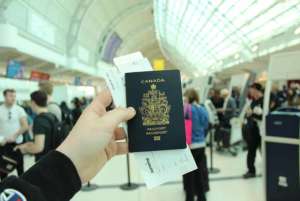Como William Hoffa escribe en su libro “todo viaje tiene potencial educativo, cualquiera que sea su inspiración.” You maybe don’t know what I’m talking about.
As William Hoffa writes in A History of Study Abroad, any (and all) travel “has educational potential, whatever its inspiration and purpose. What and how much is learned, however, depends greatly on how open the traveler is to what the road offers.”
I personally wanted to be an exchange student and come to the U.S. because I wanted to grow as a person; know a new culture and be more independent.
When I did my first interview to be a exchange student I didn’t understand why they asked me questions such as “what would happen if you get a family that lives in a farm in the middle of nowhere?” “what if you had to wake up at 5am everyday?” and “what if you are chosen by a family with a religion different than yours?” By that time I thought it didn’t make any sense that they asked me this type of questions even before testing my English. I’ll get back to this point later, but let’s start with the history of the exchange student programs, statistics and how to become a exchange student or host one.
According to an article written by journalist Megan Lee, The first ever “study abroader” was Emo of Friesland, who travelled from Holland to study at Oxford University in 1190. He paved the way for international exchange in Europe for the following years. In the mid-19th century, educational representatives from Germany, France, and England met in London to design a plan for sustainable international education programs. Meanwhile, John Diomatari from Greece, was the first ever known international student to attend an American university, the University of Georgia. Forty years later, Indiana University began hosting a series of study abroad programs where university students were invited to European destinations during the summer holiday to study history, language, and culture. With the First World War coming to an end, several American organizations started to explore creative ways to inspire their students to learn more about the world outside of US borders. And, later, with the end of the Second World War President Roosevelt challenged all Americans to learn more about the world. According to him “A nation, like a person, has a mind – a mind that must be kept informed and alert, that must know itself, that understands the hopes and needs of its neighbors — all the other nations that live within the narrowing circle of the world.”
However, as we moved away from the decade of the war, the government didn’t give priority to the exchange programs, because they thought this programs did not help prepare students for the future. This resulted in a decline of exchange for the next 20 years. With the Cold War, passionate Americans were once more interested in international affairs and the global community, and the following two decades saw an incredible increase in exchange programs in American universities. Though there have been problems with the post wars generations, student exchange has help create an open minded outlook.
According to the 2016 Open Doors document by the Institute of International Education higher level foreign exchange students has increased by 85% over the last 10 years – at the universities, colleges and schools across America there are approximately a million people who study abroad, including me.
Top destinations in the U.S. are California, New York and Florida. And I ended up in Portage. It is well known that travelling abroad can be expensive. In fact, according to the U.S. Department of Commerce, in 2015, international students contributed more than $35 billion to the U.S economy. Because of this, several governments have invested in scholarship programs creating a large increase in students interest.
In addition to cost, there are other important ideas to consider as a foreign exchange student, including adjustment. Grace H. Pardede, a student at Baylor University, published a study in which she shows different aspects during the adjustment of 79 participants to their new host country. Using a 5 point Likert scale, where the higher number means more difficulty in adjustments, her study shows that adjustment to a new environment and culture in their host country is a 2. Participants, also, ranked their level of homesickness based on a 4-point Likert scale, a great number of students scored at the midpoint and above in this scale. Scores show that students miss home a 2.46 and feel missed by their family a 2.76. Scores also show that students feel lonely at 2.02 points. This is such a normal feeling while you are away that a pattern was created, this pattern is called “The W Curve”. It represents that when a person arrives in their host country they feel excitement and begin in an emotional high point, yet as the person begins to adjust to living in their host environment, they become homesick. When the time of leaving comes, the student feels the same excitement to go home as felt the time that arrived to the host country. Once in the home country, the student starts the reverse culture shock, to get used to the old habits and traditions. And finally the student adapts to the life again in the home country. I can confirm that this graph is accurate. Starting out, I remember feeling really excited to experience a new life but as I was developing a routine my energy was lower. And now, halfway through my exchange year, I can say that things are looking up.
Whether you are a parent, teacher, potential exchange student, or interested in becoming a host family, you should know that living and studying in another country can be one of the most amazing and rewarding experiences, but it takes a little effort to get there. If you are a parent just know that it will help your son or daughter, they will have confidence and independence, not to mention language skills and international vision. If you are a teacher, many of your students don’t get involve in this programs simply because they aren’t aware of the options that exist for them. You play an important role in connecting students with programs.
If you want to become an exchange student, the first thing you should do is research programs and make sure you meet any admissions requirements the program may have such as age or GPA. The next step is decide if you want to go for a trimester, a semester or a full school year. Trimesters are much cheaper, and you can get a good taste of the culture by being there a few months. Semesters are usually the best option because you’re not away from home for too long and you have enough time to get a great experience. Full school years, like what I am doing, are the most culturally stimulating but it comes at a high cost, and you’ll be away from home for 9-10 months. Once you have filled out the application, and get accepted, get ready for the shock of realizing that your version of America was based on The High School Musical, or reruns of Friends and How I Met Your Mother.
If you want to be a host family you just have to make sure you will give your student a place where they feel comfortable, and receive time and enthusiasm. There’s not a “typical” host family. It doesn’t matter if you are a family with children, a couple, or a single person. Just research an organization that you trust in and apply for it. Once you have applied, the local coordinator would probably go to your house for an interview and with this done it will be the time to choose a exchange student.
As the world is getting bigger, international relationships are more important, and exchange student programs brings new perspectives. I currently live in a residential neighborhood in a town, not on a farm in the country. I don’t need to wake up at 5:00 am, unless,of course, it is a Forensics Saturday. And the religion of my host family is similar to mine, but not quite the same. The questions asked of me in the beginning helped me realize that anything could be possible, and that the program is about the experience and the people. The effort, while large, is worth it.

The Case for Student Exchange









